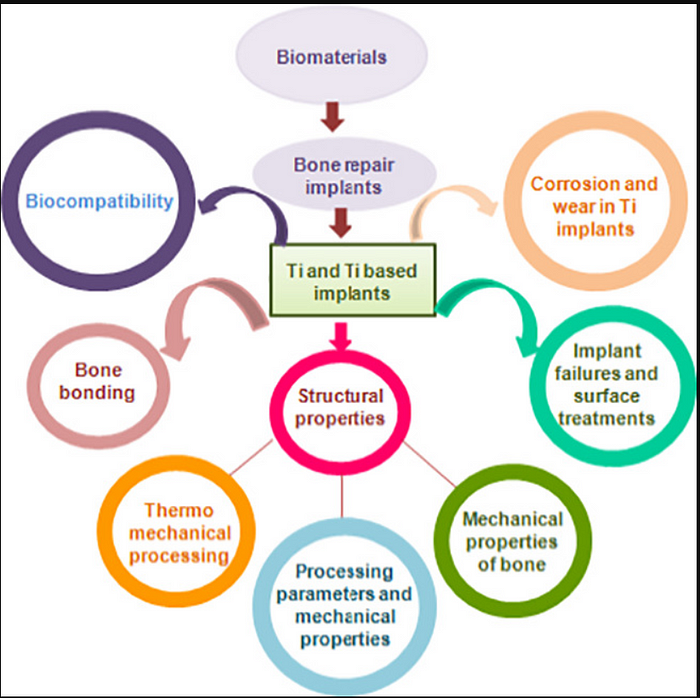
Biomaterials Applications
Abstract
The article is created as part of a curriculum assignment for Biology for engineers on Biomaterials. In this article, I would like to provide a glimpse of the definition of biomaterials, their current and future applications
Introduction
Biomaterials are those materials — be it natural or synthetic, alive or lifeless, and usually made of multiple components — that interact with biological systems. They are often used in medical applications to augment or replace a natural function
It is a substance that has been engineered to interact with biological systems for a therapeutic or diagnostic purpose. As a science, biomaterials are about fifty years old. The study of biomaterials is called biomaterials science or biomaterials engineering.
The study of Biomaterials is called Biomaterial science or Biomaterial engineering. Biomaterials science encompasses elements of medicine, biology, chemistry, tissue engineering, and materials science.
A biomaterial is different from a biological material, such as bone, that is produced by a biological system. Additionally, care should be exercised in defining a biomaterial as biocompatible, since it is application-specific. A biomaterial that is biocompatible or suitable for one application may not be biocompatible with another
Biomaterials can be derived either from nature or synthesized in the laboratory using a variety of chemical approaches utilizing metallic components, polymers, ceramics, or composite materials. They are often used and/or adapted for a medical application, and thus comprise whole or part of a living structure or a biomedical device that performs augments, or replaces a natural function. Such functions may be relatively passive, like being used for a heart valve, or may be bioactive with a more interactive functionality such as hydroxy-apatite coated hip implants. Biomaterials are also used every day in dental applications, surgery, and drug delivery. For example, a construct with impregnated pharmaceutical products can be placed into the body, which permits the prolonged release of a drug over an extended period of time. A biomaterial may also be an autograft, allograft, or xenograft used as a transplant material
Applications
Biomaterials are used in many area-like Joint replacements, Bone plates, Intraocular lenses (IOLs) for eye surgery, Bone cement, Artificial ligaments, and tendons, Dental implants for tooth fixation, Blood vessel prostheses, Heart valves, Skin repair devices (artificial tissue), Cochlear replacements, Contact lenses, Breast implants, Drug delivery mechanisms, Sustainable materials, Vascular grafts, Stents, Nerve conduits, Surgical sutures, clips, and staples for wound closure, Pins and screws for fracture stabilization, Surgical mesh
Biomaterials must be compatible with the body, and there are often issues of biocompatibility, which must be resolved before a product can be placed on the market and used in a clinical setting. Because of this, biomaterials are usually subjected to the same requirements as those undergone by new drug therapies. All manufacturing companies are also required to ensure traceability of all of their products, so that if a defective product is discovered, others in the same batch maybe traced.
Latest Research
Smart biomaterials have the ability to respond to changes in physiological parameters and exogenous stimuli and continue to impact many aspects of modern medicine. Smart materials can promote promising therapies and improve treatment of debilitating diseases. Here, we describe recent advances in the current state-of-the-art design and application of smart biomaterials in tissue engineering, drug delivery systems, medical devices, and immune engineering. In the following areas, researches are done so that it can be utilized for that as well.
Fully implantable and bioresorbable cardiac pacemakers without leads or batteries: -
Temporary cardiac pacemakers used in periods of need during surgical recovery involve percutaneous leads and externalized hardware that carries risks of infection, constrain patient mobility and may damage the heart during lead removal. Here we report a leadless, battery-free, a fully implantable cardiac pacemaker for postoperative control of cardiac rate and rhythm that undergoes complete dissolution and clearance by natural biological processes after a defined operating timeframe. We show that these devices provide effective pacing of hearts of various sizes in mice, rat, rabbit, canine, and human cardiac models, with tailored geometries and operation timescales, powered by wireless energy transfer. This approach overcomes key disadvantages of traditional temporary pacing devices and may serve as the basis for the next generation of postoperative temporary pacing technology.
Injectable non-leaching tissue-mimetic bottlebrush elastomers as an advanced platform for reconstructive surgery: -
Current materials used in biomedical devices do not match tissue’s mechanical properties and leach various chemicals into the body. These deficiencies pose significant health risks that are further exacerbated by invasive implantation procedures. Herein, we leverage the brush-like polymer architecture to design and administer minimally invasive injectable elastomers that cure in vivo into leachable-free implants with mechanical properties matching the surrounding tissue. This strategy allows tuning curing time from minutes to hours, which empowers a broad range of biomedical applications from rapid wound sealing to time-intensive reconstructive surgery. These injectable elastomers support in vitro cell proliferation, while also demonstrating in vivo implant integrity with a mild inflammatory response and minimal fibrotic encapsulation.
Conditioning the microenvironment for soft tissue regeneration in a cell-free scaffold: -
The use of cell-free scaffolds for the regeneration of clinically relevant volumes of soft tissue has been challenged, particularly in the case of synthetic biomaterials, by the difficulty of reconciling the manufacturing and biological performance requirements. Here, we investigated in vivo the importance of biomechanical and biochemical cues for conditioning the 3D regenerative microenvironment towards soft tissue formation. In particular, we evaluated the adipogenesis changes related to 3D mechanical properties by creating a gradient of 3D microenvironments with different stiffnesses using 3D Poly (Urethane-Ester-ether) PUEt scaffolds. Our results showed a significant increase in adipose tissue proportions while decreasing the stiffness of the 3D mechanical microenvironment. This mechanical conditioning effect was also compared with biochemical manipulation by loading extracellular matrices (ECMs) with a PPAR-γ activating molecule. Notably, results showed mechanical and biochemical conditioning equivalency in promoting adipose tissue formation in the conditions tested, suggesting that adequate mechanical signaling could be sufficient to boost adipogenesis by influencing tissue remodeling. Overall, this work could open a new avenue in the design of synthetic 3D scaffolds for microenvironment conditioning towards the regeneration of large volumes of soft and adipose tissue, with practical and direct implications in reconstructive and cosmetic surgery.
Conclusion
It appears that it is appropriate to approach the future of biomaterials and biomaterials processing with great optimism tempered with prudent caution as we move from replacing to regenerating tissues. The lessons of the past should caution us that our knowledge concerning the performance of biomaterials is incomplete, even in the more traditional areas. Given the complex, materials-specific causal patterns involved in the cases examined, it is hard to imagine that IT techniques such as data mining could have any utility at all in biomaterials and medical device risk reduction. The relevant data are simply not there to be mined. However, individual patients or patient groups are increasingly getting information concerning the risks and performance of their implants via the Internet, and their risk information is now often comparable to that of their physicians. Appropriate post-market surveillance, while perhaps lacking visionary appeal, appears to be a valuable risk management tool as well as a source of insights for continued improvement in the performance of biomaterials and future tissue regeneration procedures. Caution should especially be exercised in introducing change in areas where the current performance of biomaterials and devices has had an excellent track record. On the other hand, taking no risks is not in the long-term best interests of the patient population. Therein lies the balance and the challenging future of biomaterials as we move in the direction of regeneration rather than replacement of tissues.
References
